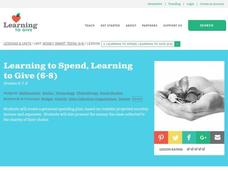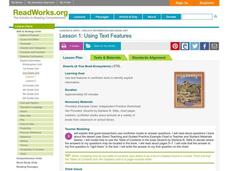Curated OER
Analyzing Relationships
Students explore relationships between story characters. In this story elements and reading comprehension lesson, students generate character traits of the characters in Bridge to Terabithia, by Katherine Paterson. Students describe...
Curated OER
Creating and Outline From Research
Fourth graders develop 3 research questions about a topic they choose and categorize the information they have learned. For this research lesson plan, 4th graders use a variety of non fiction materials from the library.
Curated OER
Learning to Spend, Learning to Give
Students create a monthly budget. In this finances lesson, students learn the terms budget, income and expenses. Students create a monthly spending plan and keep track of what they make and spend for the next 30 days. When complete,...
Curated OER
People Who Work
Students chart volunteers they are familiar with in school, church or in the community. In this nonprofit jobs, lesson students understand that all members of a community need to take responsibility in that community. Students vote on...
Curated OER
Let us Help
Students explore water conservation. In this ecology and civic responsibility activity, students identify agencies that monitor and help improve water quality and describe what they do. Students research these organizations and work in...
Curated OER
Academic Service Learning: Creating the Philanthropy Resource
Students complete a service learning project. They interview non-profit organizations of their community and develop listing information for each organization. They also develop a list of career opportunities for the community.
Curated OER
Active Citizenship through the Spectacles of Benjamin Franklin
Students research and identify ways that Benjamin Franklin contributed to society. They identify the core democratic values and how he achieved them. They research organizations in their area that give back to the community.
Curated OER
Who Should Do It?
Young scholars identify the four sectors of the economy and give examples of their responsibilities. They describe how a mission statement identifies the focus of a foundation.
Curated OER
Changing for the Common Good
Students examine the nonprofit sector and how it has made positive changes in society. They create a timeline noting events related to disadvantaged groups. They work together to research the events.
Curated OER
Defining Philanthropy -- Who's Phil's Aunt Trophy?
Students identify and define key terms associated with philanthropy. They list ways in which people can give to help others. They finally name philanthropic organizations they are familiar with.
Curated OER
Growing Up
Students examine the definitions of philantrophy and common good. They identify non-profit organizations in their community and research organizations that existed in colonial times with the same goal in mind. They create a timeline for...
Curated OER
Match the Environment Group with the Correct Sector
Students identify different types of environmental organizations. They connect each organization to one of three economic sectors. They examine how each organization is different in their goals and purposes.
Curated OER
Dividing the Philanthropic Shares
Students define who volunteers are the and the types of jobs that they do. They identify various groups who volunteer in their community, and locate them on a city map.
Curated OER
Exploring Our Community
Students identify nonprofit and profit organizations in their community. They discuss why it is important to have both types of organizations. They create a land use map of their community.
Curated OER
Medical Explorer: The Big Idea
Read informational text which relays how medical care differs around the globe and throughout history. There are three separate lessons, each focused on a particular case study, regional medical availability, and cultural norms. Learners...
Curated OER
Using Text Features
Investigate a "table of contents" with your students! They read the table of contents in Deserts by Darlene R. Stille and predict where the answers to specific questions might be found. Learners complete a worksheet in which they find...
Curated OER
Predicting Events in Realistic Fiction
How do you make a prediction? Practice active reading comprehension strategies, like making predictions, with your readers. Learners make predictions during the independent reading of Dogs Don't Tell Jokes by Louis Sacher. They observe...
Curated OER
Experience and Perspective
Sixth graders make connections between past experiences and perspective. They read Keeping the Night Watch by Hope Anita Smith. Then, they analyze a character's history and state the past experiences that form their perspective. In...
Curated OER
What's the Author's Purpose?
What is the author's purpose for sharing an autobiography? Start this lesson with the short story provided about getting pulled over by a police officer. Then, discuss the acronym PIES and how it stands for the four main reasons an...
Curated OER
Genre: Short Story
Discover the genre of short stories with sixth graders. They discuss the characteristics of short stories from the book America Street. Then, they compare and contrast movies and television shows and chart story characteristics....
Curated OER
What is a mystery?
What is a mystery? Learners complete an anagram worksheet to discover the mystery genre. First, they listen as the teacher reads from All About Mysteries and notes defining words on the board. Then they read a mystery and examine it for...
iCivics
Taxation
A paycheck stub can offer loads of information on the taxes American citizens pay. This resource not only includes analysis of a stub as an activity, but also provides a wealth of informative reading material on such topics as the...
iCivics
Propaganda: What’s the Message?
As class members progress through eight fully prepared learning stations, they will identify how bias is present in persuasive media, as well as differentiate among types of propaganda techniques like bandwagon propaganda and the...
iCivics
Do I Have a Right? Bill of Rights Edition
In an online engaging and animated game, pupils role play as lawyers charged with protecting rights found in amendments to the United States Constitution. As they choose appropriate amendments to match the right that has...

























